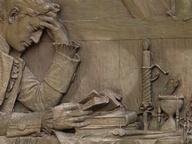Quiz Answer Key and Fun Facts
1. Which shape most resembles the narrator of the book?
2. At the time the book was set, which of the following would be considered an unsafe shape for a private house in Flatland?
3. The narrator of the book was a man. Which of the following shapes would most resemble his wife (and all women)?
4. Which of the following shapes would be considered an unsafe member of society (even unintentionally)?
5. Which shape most closely resembles the ultimate leader of Flatland?
6. The narrator of the book described a visitor from the third dimension that visited him at his home. What was the appearance of the visitor?
7. In which dimensional land do we see the narrator converse with a monarch in a dream?
8. At the time the sphere meets the narrator, what does he (the sphere) initially state are the maximum number of dimensions?
9. The narrator mentions residents of Flatland using three senses to recognize one another. Which sense is not mentioned?
10. After the narrator learns about Spaceland, he attempts to tell several people about it, including his grandson. Which of the following shapes most resembles his grandson?
Source: Author
bernie73
This quiz was reviewed by FunTrivia editor
looney_tunes before going online.
Any errors found in FunTrivia content are routinely corrected through our feedback system.

